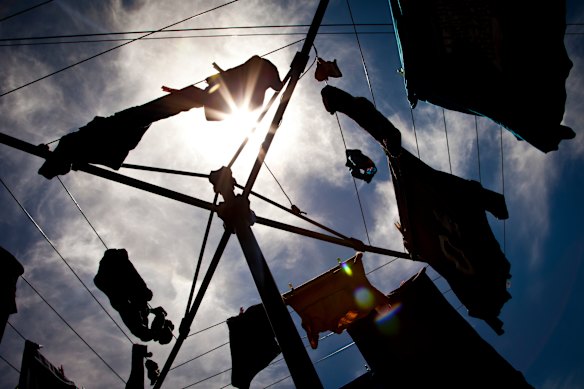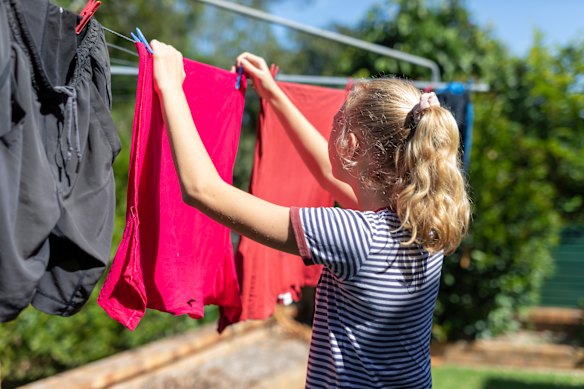Putting the washing out? Why the way you dry the clothes stirs so much debate
By Mercedes Maguire
Is there anything more alarming than the sound of thunder after you’ve just hung the third load of washing on the line? It’s a feeling of dread possibly eclipsed only by a downpour that then lasts a week.
Few topics fill Reddit forums faster or garner more Facebook opinions than whether you should line dry your clothes or not.
An American TikTokker’s post even went viral during the COVID-19 pandemic when she expressed incredulity that most people line dry in Australia. Apparently, it’s not the done thing in North America.

Drying your clothes on the line is free and environmentally sustainable.Credit: Getty Images
It’s a subject pot-holed with pros and cons on both sides. And most people have an opinion.
But at the heart of the issue are three points – cost, fashion and the environment.
“Australia invented the Hills hoist, for goodness’ sake,” says Jenny Edwards, a self-described science nerd better known as one half of the Fix It Chicks, who offer tips on how to save money and be energy efficient at home.
“As lives get busier, there is a tendency to rely on appliances that save time,” she says. “But clothes dryers are one of the most energy guzzling appliances in the home, especially if using them becomes the default, and the routine is to leave them on for too long. From a cost and environment standpoint, what’s cheaper or cleaner than the sun and fresh air?”
That argument is all well and good for dry days, but what happens when it rains on the day you need to wash or, worse still, it rains non-stop for a week?
While a clothes dryer can account for up to 10 per cent of your home’s energy consumption, one with a good energy rating – preferably a heat pump dryer that can reduce energy consumption by about 28 per cent compared to other dryers – is a good solution. A heat pump dryer works by heating the air and using that to draw moisture from the clothes without expelling moist air into your laundry like a vented dryer does. It also uses a lower drying temperature, so it’s gentler on your clothes.
Such technology carries a higher price tag, but it can also pay for itself over time by using less energy, according to a Finder comparison. A 7kg heat pump clothes dryer with a six-star rating will cost about $78 a year to run if you use it twice a week, but a 7kg vented clothes dryer with a 2.5-star rating will cost about $155 a year to run.
Chris Barnes, a household appliance expert for consumer watchdog, Choice, says where possible, line drying outside is ideal. But on rainy days, a clothes dryer is not the only alternative.
“There are a variety of methods people use for line drying clothes inside,” he says. “But you have to be aware that when you line dry clothes inside, the moisture that is removed from your clothes has to go somewhere; it can collect inside your home and you risk a build-up of mould indoors. Some people use a dehumidifier to remove the moisture from the air – and some even come with a laundry setting – but unless you have a damp home and already have a need for one, I wouldn’t be buying a dehumidifier just for clothes drying.
“Regardless of whether you dry clothes inside or outside, air circulation is of utmost importance and inside a home you can achieve this by hanging clothes by an open window, using a dehumidifier or a basic fan on a gentle setting.”

Line drying is often better for your clothes, as long as you can protect them from fading.Credit: Getty Images
And when it comes to caring for fabrics and getting longevity from your clothes, the message is simple – line drying is usually the way to go. But there are some items that should never be line dried. These include thick jumpers and heavy knit blankets which, when made heavier with water, can become stretched and misshapen on the line, and down-filled items which may stay clumped unless tumble dried.
Online posts about how to do laundry correctly spawn comment after comment, from cleanfluencers (they’re a thing), stay-at-home parents and anyone else who has to complete the chore.
Here are some common line-drying beliefs:
- Sunlight is antibacterial: The sun’s UV rays can kill bacteria, but the items must be left to dry completely in the sun.
- The sun can damage clothes: This is true, garments can fade if left for extended times in direct sun, and some delicate fabrics like silk and lace can warp or shrink. Ideally, dry in the shade.
- Rain dirties clothes on the line: It depends on the environment. If you live in a dusty, dirty or high pollution area, rewash your clothes if heavily rained on or if they’re in the rain for several days because moisture fosters bacteria.
Make the most of your health, relationships, fitness and nutrition with our Live Well newsletter. Get it in your inbox every Monday.